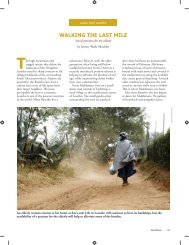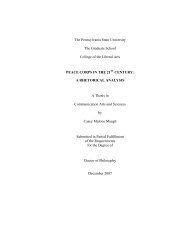Rural Internet Kiosks -â Overview - Africa Rural Connect
Rural Internet Kiosks -â Overview - Africa Rural Connect
Rural Internet Kiosks -â Overview - Africa Rural Connect
Create successful ePaper yourself
Turn your PDF publications into a flip-book with our unique Google optimized e-Paper software.
Infrastructure Challenges and Solutions There is a conviction and consensus on the potential of ICTs as tools for sustainable development particularly at the level of rural and local access. ICTs can be used in increasing access to healthcare, education, and business opportunities; they can help in decreasing vulnerabilities and improving citizen engagement with governments and their institutions. There has been a call for the promotion and adoption of a multi-‐sectoral approach in achieving universal, affordable and equitable access. According to the International Telecommunications Union, <strong>Africa</strong> has seen unprecedented growth in the ICT sector over the past 4 years surpassing South <strong>Africa</strong> for the number of mobile subscribers in 2009. The telecommunications sector has steadily grown more than 25% per year for the last 5 years. With this uptake of ICT the next logical step is universal internet connectivity beginning in educational facilities. Due to a lack of connectivity, the “developing world missed out on much of the excitement of the initial web revolution, the dotcom boom and Web 2.0, largely because it did not have an internet infrastructure. But developing countries may now be poised to leapfrog the industrialized world.” (Economist, 2008) There is no reason why <strong>Africa</strong> should struggle to follow the same path to development as the industrialized world. <strong>Africa</strong> can learn from the mistakes of the “developed” countries and leap ahead utilizing new green technologies that were unheard of 50 years ago. One such opportunity is solar energy. It is challenging without electricity to deploy computers and other information and communications technologies. Rather than stumbling over this hurdle and forgetting those in need, Intersat began testing different ICT hardware capable of running on solar energy. The typical desktop computer requires 210 Watts of electricity to operate. With its high energy consumption, a solar power solution is unfeasible as the cost would be exorbitant. Due to this factor we began testing a number of different low power solutions and have come up with a variety of new computing products that can run on less than 60 Watts. The decrease in power consumption created an increase in hardware costs. Thus the cost of the new technologies would have been out of reach for a majority of rural users. Rather than saying rural computing is not cost effective, we continued to search for solutions to the cost effectiveness quagmire. The answer is multi-computing.Infrastructure is essential for access: without it, people cannot use the services that networks make available. However, meaningful access – at the community or individual level – requires more than infrastructure. People also need the funds to afford access, the skills required to make use of services and equipment, and the availability of content which is of value to them.
















